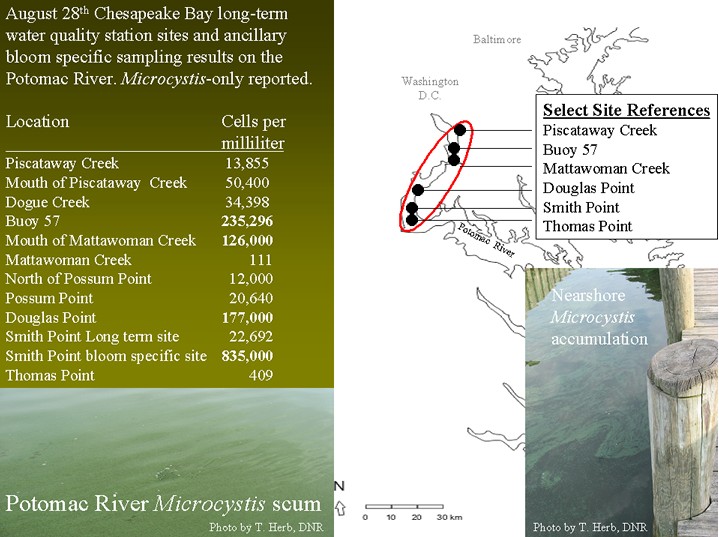|
||||||||||||||||||||||||||||||
Water quality monitoring on August 28 by Maryland Department of Natural Resources (DNR) and Morgan State University Estuarine Research Center (MSU) field teams showed cyanobacteria (also called blue-green algae') levels have intensified over the area from the mouth of Piscataway Creek ( Prince Georges County ) to Smith Point ( Charles County ) on the Potomac River . The maximum bloom concentration among the DNR long-term monitoring stations was recorded from the mouth of Piscataway Creek with 50,400 cells per milliliter (Table 1). However, higher density conditions were encountered over the region. Additional samples were collected by both groups where scum accumulations were developing and showed peak concentrations of 853,000 cells per milliliter near Smith Point , MD. Areas showing concentrations above 100,000 cells per milliliter occurred from Buoy 57 of Chapman Point, MD (235,296 cells per milliliter) to Smith Point (Figure 1).
Figure 1. August 28, 2006 Potomac River water quality monitoring results for Microcystis
Due to the high levels of cyanobacteria encountered in the region, an advisory cautioning recreationalists about the water quality conditions has been released today ( See the August 31 Interagency Press Release Blue-green algae blooms reach cautionary levels on the Potomac River, Charles and Prince Georges County ). Four samples were sent out for laboratory toxin tests; results are pending. Maryland Department of Natural Resources will again monitor the Potomac River on September 5, 2006 .
Table 1. Cyanobacteria cell counts on the Potomac River long-term water quality monitoring stations, August 14th and 28th 2006.
Maryland Department of Natural Resources will continue to actively monitor and report on the condition of the river. Citizens are advised to take common precautions around bloom waters to reduce the possible risk of illness or discomfort related to blue-green algal blooms:
|

